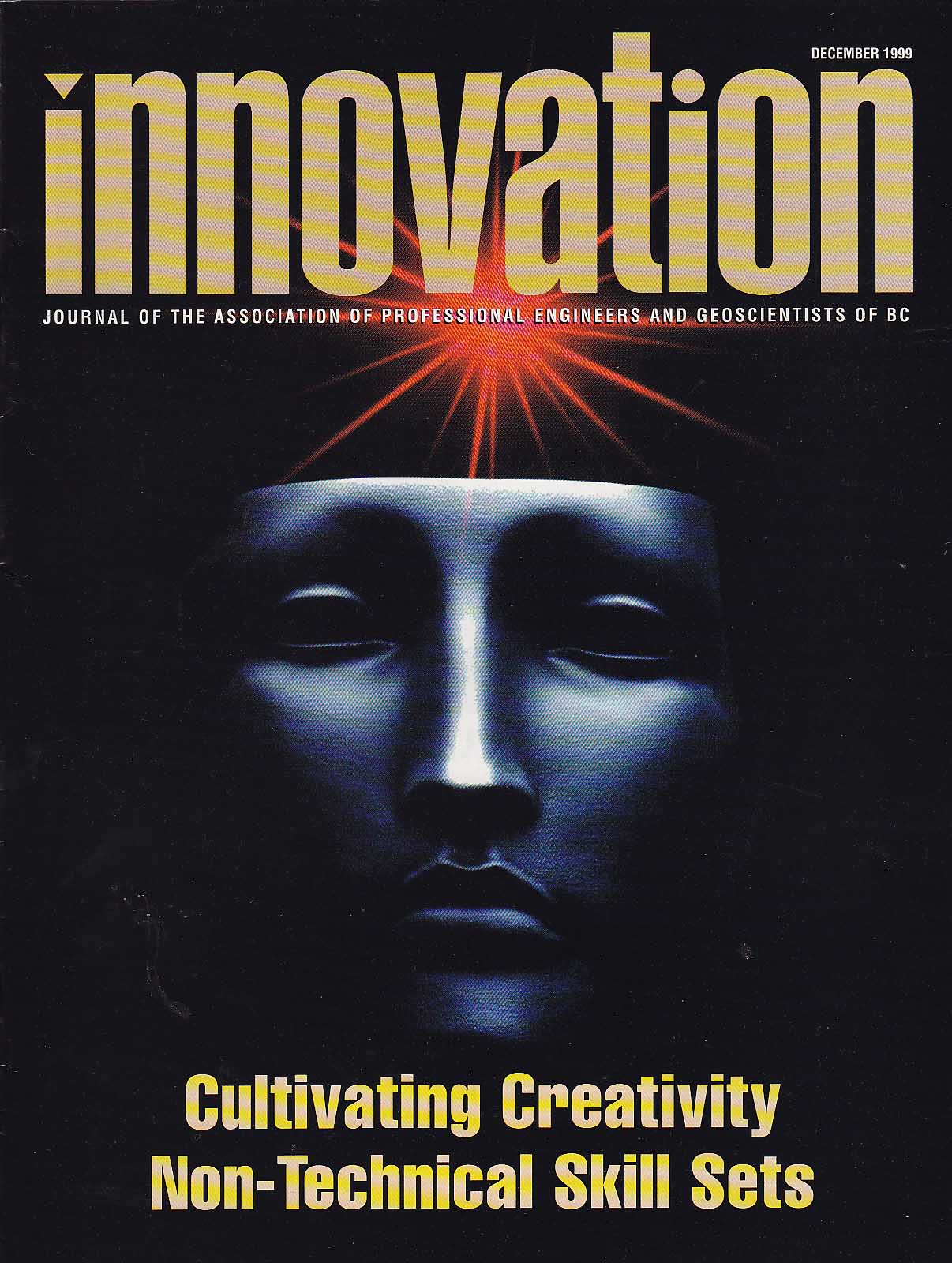It is a fact that in many technical organizations, prolific "idea-people" have usually been seen as to unstable to head engineering development teams. Having successfully negotiated the rigors of demanding engineering curriculums, most engineers feel that all they need for a productive career is to continue harnessing the intelligence that permitted them to enter the profession in the first place. There is an unspoken assumption that if you are "intelligent", then you are automatically a creative thinker. In other words, the belief is that thinking is merely the exercise of intelligence. There are two significant consequences of this belief, namely, that if you're not "intelligent", there's nothing that you can do about it and, if you are "intelligent", then there is not much that can be done to improve your thinking skills because you have everything you need already. One tragic result of this false presupposition is the widespread misconception among engineers that innovative thinking and creativity are mostly innate and cannot be taught as a skill or improved upon.
The fact is that many highly intelligent individuals are actually poor innovators, while people of average or even below-average intelligence can be capacious innovators and skilled creative thinkers. Just as the power of a gun is separate from the skill and accuracy with which it is fired, the power of a mind is separate from the thinking skills of the owner.
 Surprisingly, intelligence can actually prove to be a significant handicap to creativity. The intelligent person can take a firm position on any topic and proceed to construct a rational and articulate defense for their point of view. However, the better the defense, the less the thinker needs to explore the subject in any depth and/or to seek alternate points of view. The result is that many intelligent professionals find themselves locked into rigid perceptions of what constitutes an “acceptable” solution to a particular problem. Intelligent people are often able to quickly generate the "right" answer, but this is not the only possible solution nor is it likely to be the most creative one. A less intelligent person, unable to immediately get the "right" answer, is far more likely to more fully explore a topic for obscure alternate solutions.
Surprisingly, intelligence can actually prove to be a significant handicap to creativity. The intelligent person can take a firm position on any topic and proceed to construct a rational and articulate defense for their point of view. However, the better the defense, the less the thinker needs to explore the subject in any depth and/or to seek alternate points of view. The result is that many intelligent professionals find themselves locked into rigid perceptions of what constitutes an “acceptable” solution to a particular problem. Intelligent people are often able to quickly generate the "right" answer, but this is not the only possible solution nor is it likely to be the most creative one. A less intelligent person, unable to immediately get the "right" answer, is far more likely to more fully explore a topic for obscure alternate solutions.
Furthermore, the simplest path to instant achievement for an intelligent person is by proving someone else wrong. If you start out developing an innovative concept from scratch it takes time, endless trial and error and constant exposure to the risk of rejection. It is much faster and certainly more ego-boosting to prove someone else’s new idea wrong instead of creating your own ideas from scratch.
Creative thinking is a skill that can be taught. When rain falls onto a sloping, fine-sand beach, non-homogeneous areas in the sand lead to the formation of channels that allow the water to rapidly drain away before it has a chance to soak into the ground. In the same way, years of thinking in the same set patterns leads to a mental state where fresh ideas tend to rapidly run off before they can soak in anywhere and do any good. Creative thinking techniques allow the tributaries of the mind to be harnessed up so that they may flow in new and possibly more innovative directions.
Engineers have traditionally been trained to solve explicit problems such as finding the solution of n-equations in n-unknowns. In such problems, all the required information is provided and solution requires the application of a specific strategy that will work for all problems of a given type. Unfortunately, the nature of the 21st century economy will mean that the types of problems that engineers will have to solve will tend to be implicit in form, where all the information required for solution is available but it is fragmented, dispersed and requires highly developed perception skills to extract and use successfully. The thinking skills engineers need to solve even the simplest implicit problems are not presently being taught in Canadian institutions.
An example of a simple implicit problem is the following: Two women are sitting on a park bench talking. The first says: "I have three children." The second asks: "What are their ages?" The first replies: "I will give you hints and stop me when you have enough information to calculate their ages. (1) The sum of their ages is 13. (2) The product of their ages is the same as your age. (3) My oldest daughter loves peanut butter."
"Stop!" cries the second woman, "I know their ages." Do you?
Even though the solution of this problem requires only Grade 3 math skills, the majority of professional engineers cannot solve this problem! Perhaps it is because the average 40 year-old engineer is only about 5% as creative as the average eight year old.
If we accept that education as it is now structured is killing creativity and is not adequately preparing Canadians in general and engineers in particular to function productively in the 21st Century economy, what is to be done? Creative thinking skills are not formally taught in Canadian elementary, secondary or post secondary educational institutions. While virtually every American Ivy League university has a fully endowed Chair of Creative Thinking with at least one full time professor who teaches thinking as a skill to undergraduates in many different departments, no such positions exist in Canadian universities. The only high-level creative thinking courses now available to engineering professionals are offered by the Continuing Education Departments of a small number of post secondary institutions.
Creative thinking encompasses a broad spectrum of separate specialized thinking skills. In order to prosper in the next century, professionals in all fields will have to sustain creative thinking with the following attributes:
Aware: Thinking that is meta-cognitive (self-aware) and that is critical of the flaws that
appear in its patterns and practices.
Clear: Thinking that is well-organized, coherent, accurate and clear and that
is independent of individuals’ personal prejudices, values, standards
and beliefs.
Strategic: Thinking that is forward-looking where actions are taken with proper
foresight and planning for consequences and implications.
Scope: Thinking that is broad in scope, inclusive, context sensitive,
flexible and adaptive.
Profound: Thinking that seeks comprehensive underlying principles in the form of
demonstrable theories, laws and axioms that will link diverse ideas
and concepts and is reason-based on scientific evidence rather than
on political, cultural or magical considerations.
Curious: Thinking that is always questioning, inquisitive, wondering, probing, open-
minded, exploratory and endlessly curious.
Accurate: Thinking that is sound, intellectually careful, complete, thorough, fair,
supported by evidence, concerned with conforming to the truth,
functional, relevant, inclusive of constraints and judicious with the facts.
Progressive: Thinking that does not attempt to solve an entire problem once and for
all time but recognizes an on-going process of knowledge building, accepts
further challenges and seeks new ways of dealing with them in turn.
Perceptive: Thinking that perceives problems in novel ways and enables the solution
of implicit problems where the information necessary for solution has to be
extracted from a noisy background.
Persistent: Thinking that does not stop with the generation of one satisfactory solution
but continues to generate long chains of creative possibilities limited only
by time constraints.
Flexible: Thinking that is able to jump outside of traditional patterns and uses a variety
of creative thinking tools.
Dialectical: Thinking that is able to examine both sides of an issue and is able to
reverse itself when necessary.
What then is the mind-set of the successful entrepreneur-engineer trained in creative thinking skills? As an example, an engineer who is constantly called upon to deliver lectures in locations around the world uses flying time as assimilation time. Rather than passively waiting for what is brought to her on the plane, she buys a dozen or more different magazines on subjects completely unrelated to her area of specialization. During the flight, she reads each publication actively by sampling broadly but reading selectively. The most desirable targets are articles that contain not blood, scandal, or dry technical data, but ideas. Since ideas are the currency of the innovator, when these are encountered the engineer takes the time to jot down some brief notes for future reference. The most desirable ideas are those that jump out as being new, different, contrary to tradition, challenging to long-held assumptions, incongruous, fearsome, excitement-generating or offering new solutions to old problems.

The mind-set of the innovator is to always be on the lookout for the unexpected, to constantly be expanding one’s world view while engaging in a never ending war of challenging assumptions. The innovator looks for as-yet undetected patterns, problems that have yet to become serious enough to be widely noticed and possible opportunities that could arise from these. While observing, the questions running though the innovator’s mind could include: How has the amount of space and time devoted to the coverage of each topic changed from last week, last month and last year? What is it that can be extracted from each item that is new, surprising, contradictory, stunning or odd? By gathering information intuitively, what inferences can be made? Do any of the ideas present new solutions to long-standing problems? Is there anything to indicate that a shift is taking place in the way that people perceive the world? Can any of the new ideas potentially lead to breakthroughs in science or in the way business is conducted? Are changes occurring in society's basic values or priorities?
Successful innovators will be those able to spot once-marginal trends are moving towards the mainstream and offer opportunities for exploitation. They are particularly interested in the linking of sociological with technological trends, since these often offer the greatest chances for the generation of creative solutions. For example, the exponentially growing hunger for new telecommunications bandwidth because of the explosive growth in Internet use, has opened unlimited opportunities for engineers able to deliver innovative fiber optical and IC solid-state laser innovations.
The innovator knows that the ability to correctly recognize a developing threat confers a significant advantage. When new trends are running counter to one’s established position, this is the time when creative ideas can be most effectively proposed. The innovator-engineer is never too proud to look at what the competition is doing to solve a problem and to find a creative way of doing it better. The innovator seeks to take advantage of these new ideas by treating them as a wave that can be "surfed" to new opportunities. The capacity for critical observation, the mastery of a comprehensive collection of creative thinking techniques combined with the endless and energetic search for new opportunities is the soundest way of preparing the mind for the generation of innovative solutions. This is what will allow the professional engineering entrepreneur to prosper in the demanding and chaotic environment of the 21st century.
Dr. Tinari is the director of the Pacific Institute for Advanced Study, Canada's first virtual R & D organization. He is also CEO of Buzz 3D Printing Inc. He has taught creative thinking to thousands of engineers, managers and senior executives over the last ten years. He can be reached at: tinarip@yahoo.com or: 604-760-5088

